⋆⁺₊⋆☾ Historian ⋆⁺₊⋆ ☾ Hoarder of old books ⋆⁺₊⋆ Rambles/Reviews of Vintage Films ☾ My odd escapism into the peculiar world of vintage films #film review or search "film review" for my movie reviews
Don't wanna be here? Send us removal request.
Photo
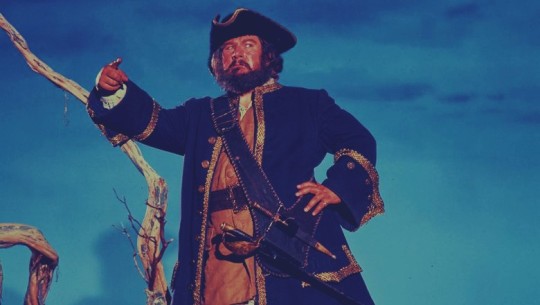
🏴☠️ Here Be Pirates.....or at the least a singularly jolly pirate of ill repute
🧭 ⚔️ An exhaustive film review of Disney’s Blackbeard’s Ghost (1968).
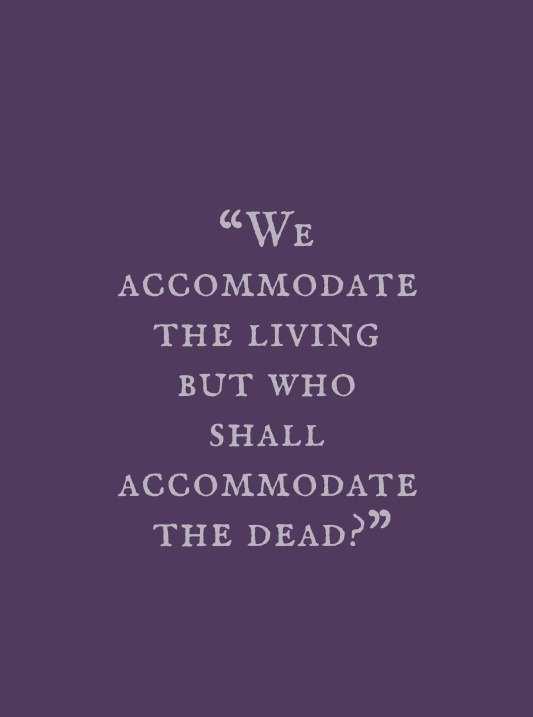
Having read other reviews of this jocular cinematic farce, I unearthed assorted scathing reviews that tend to focus with choking gloves on the film's lack of historical accuracy. The humorous quandary? I doubt Disney had in mind a historical replication when conjuring this film to existence. For those curious bystanders, I am a historian. However, there are times when for comedic necessity, artistic liberties must be admissible. Such is the case with Peter Ustinov’s drifting pilfering-plunderer. Rather, Disney focused on the ghost aspect of the retelling, attempting to wield a believably good-natured human being for the savage historical figure. This film bears an almost Scooby-Dooish aura blending a good measure of both cartoonish spookisms and a spoonful of Disney’s atmospheric Sleepy Hollow (1949). However, if you are a ghost hunter in quest of a hair-raising reverie, you are likely to meet with disappointment. Nevertheless, Robert Stevenson’s ghost story makes for a delightfully outlandish Halloween film. Stevenson was no stranger to the supernatural: this film was preceded by the Banshee-laden Darby O’Gill and the Little People (1959) and followed by Bedknobs and Broomsticks (1971).
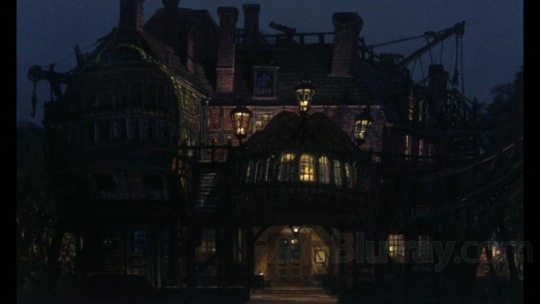
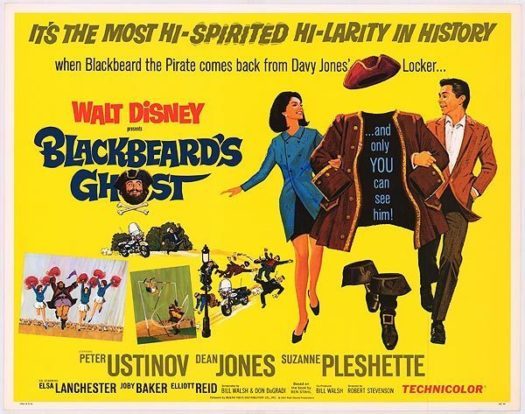
A few years earlier, in 1966, Don Knotts chanced a comedic encounter with an unseen organ-playing ghost in The Ghost and Mr. Chicken (1966). Though with its light-hearted moments, Steven’s ghost-tale managed to capture what Alan Rafkin had not. The Ghost and Mr. Chicken imbibes a more eerie and surreal atmosphere than Blackbeard’s Ghost, which relies on comedy more than irony, suspense, and mystery. This, of course, arguably, is at the hands of the genius character of Ustinov, who balances both tragedy and jollity into a figure, that if recreated in cinema today, would likely stench of brutality. Ustinova harnesses his natural almost child-like energy with a freckle of Shakespearean monologue to craft a character who is seemingly capricious—grossly depressed and crocked at one instant and reeling and crooning the next. Stevenson does recycle the incantation sequence rehearsed in the Shaggy Dog (1959), which ironically saw Dean Jones reprising the role of Wilby Daniels in the 1976 sequel.

Did I mention that Luther encounters an eerie portrait as well?
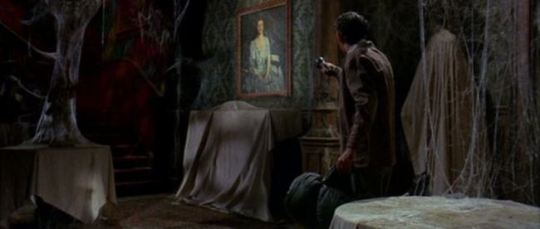
However, a more colorful plot is constructed: first, Steve Walker unwittingly suffers the brunt of a spooky retelling of the witchery of Aldetha Teach by a possessed Emily Stowecraft. One source recounts, “After a bidding war with the football coach at the charity auction, Steve wins an antique bed warmer once owned by Blackbeard's 10th wife, Aldetha Teach, who had a reputation of being a witch. Inside the hollow wooden handle of this bed warmer is hidden a book of magic spells that had once been the property of Aldetha. Steve recites, on a lark, a spell "to bring to your eyes and ears one who is bound in Limbo,” unintentionally conjuring up the ghost of Blackbeard, who appears as a socially-inappropriate drunkard, cursed by his wife to an existence in limbo unless he can perform a good deed.”
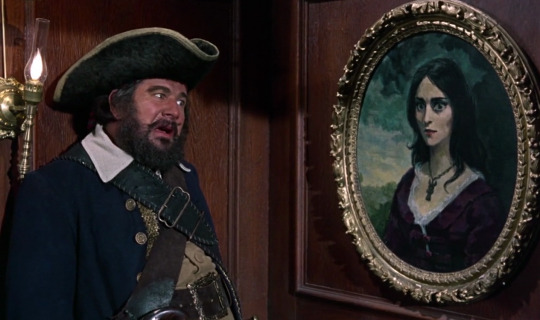
The uncanny behavior of fortune-telling Emily Stowecraft and the shivery portrait of Aldetha remain the singular instances in the film that one might deem ‘spooky.’ Yet there remains a hint of comedy here as well. So certain was Aldetha of her husband’s flagrancy that she felt confident this would prove an impossible task to accomplish, ensuring his permanent residence in the suspended universe of limbo. A more humorous question remains for the historian: how did a despised outlaw such as Blackbeard manage to procure the ears of the authorities to have his wife burned for witchcraft?
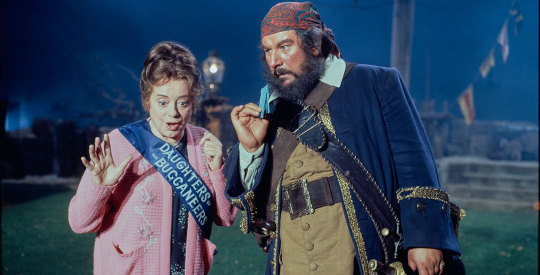
It is equally amusing that the Daughters of the Buccaneers are aware of the pirate’s spectral presence and live in unison with him without the slightest hint of trepidation, almost invoking Lucy Muir’s devotion to the captain’s ghost and his portrait (much the way Emily Stowecraft swoons at Blackbeard’s painted likeness). In classic film, portraits are as a direct means of introduction as a welcoming party, especially if the character is dead in Rebbeca’s (1940) case and with Captain Gregg.
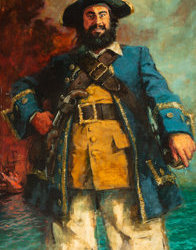
I see several artistic parallels to other ‘family’ ghost stories that Stevenson drew on. The portraits being one which echoes back to The Ghost and Mrs. Muir (1947), where our female protagonist, Lucy, initially receives an introduction to the friendly spirit, Captain Daniel Gregg. In a similar parallel, Steve’s first acquaintance with the benevolent phantom is through Blackbeard’s revered portrait. In a like manner, the phantom-captain performs various ‘good deeds’ toward the widowed mother. Lucy receives a slew of strong warnings that the old mansion is haunted as well: “Gull Cottage…has a reputation as being haunted by the spirit of a seaman who accidentally died there.” In both films, the protagonists ignore the warnings about the blithe spirits who both happen to share the occupation of seafarers.
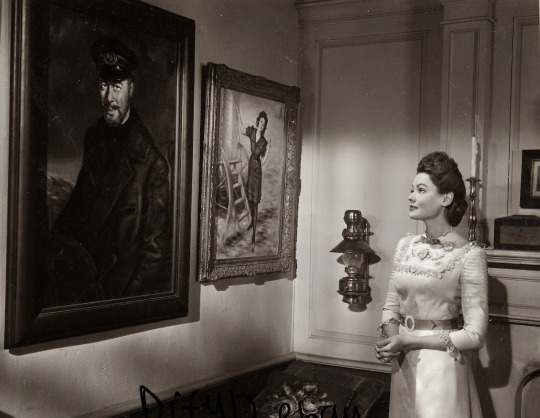
Joseph L. Mankiewicz’s masterpiece draws its life-blood from bleak atmosphere, tragic irony, and dark romanticism, whereas Stevenson relies on comedic absurdity and a cartoonishly colonial backdrop. Unlike the Ghost and Mr. Chicken, however, Luther Heggs is never quite certain whether or not the ghost exists, although, like the Daughters of the Buccaneers, the Psychic Occult Society of Rachel insists on the presence of spirits on the mansion grounds. At the least, although manifesting outright slapstick comedy, Stevenson had the good sense to draw from previous ghost films. Blackbeard’s Ghost most closely resembles the nonsensical merriment captured in the colonial ghost story Abbot and Costello in The Time of Their Lives (1946) where Horatio and Melody are imprisoned in limbo for 166 years haunting the grounds of the Tom Danbury estate.
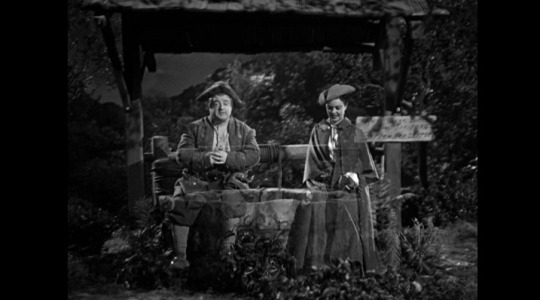
It is important to note that Stevenson had previously worked on the colonial production, Kidnapped (1960). That was an earlier film, however, completed before Walt had passed, and the production value was quite higher in terms of costume design, set props, and atmosphere. I was disappointed that more attention was not given to set design, atmosphere, and Blackbeard’s ship, Queen Anne's Revenge, glimpsed at the conclusion of the film. Where the Shaggy Dog had an intricate and well-developed plot surrounding the Borgias, witchcraft, shape-shifting, an eerie musical score, and a macabre wax museum, Blackbeard fails in this Halloweenish aspect. Where it fails in atmosphere, however, it makes up for in humor.

The Capture Of The Pirate Blackbeard In 1718, Painted By Jean Leon Gerome Ferris (c. 1863–1930)
Peter Ustinov appeared in several other Disney films, and this presented one of his funniest roles. He is quite believably a disheartened pirate, but unlike Lucy and Luther’s spirited friends, he is less hostile and quickly attaches himself to Steve. This is the beauty of an actor who is able to breathe life into their character and shape-shift into the actual persona. Is this an accurate portrayal of Edward Teach? Perhaps not, but after several hundred years in limbo, one might experience a change of heart. In keeping with the spirit (pun intended) of the other films, Steve appears psychologically disturbed to those on the periphery, making his reputation and mental wholeness questionable.
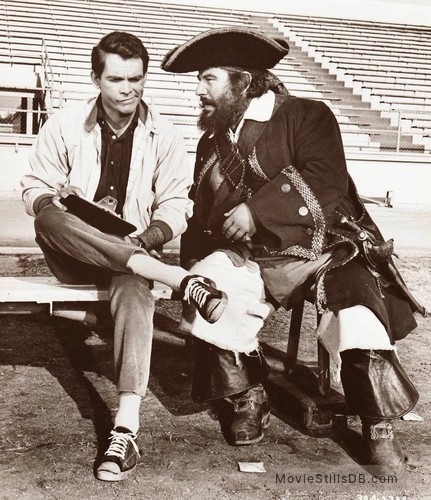
As far as dialogue is concerned, Peter Ustinov provides some colorful monologues drawing on his extensive theatrical experience, which provides a unique dichotomy to his comedic persona. For the most part, the other characters lack much development. Richard Deacon delivers a commendable performance as the panicky Dean Wheaton. Michael Conrad, as the football coach Pinetop Purvis remains true to his typically charmingly arrogant self, but if he was included as a competitor for Jo Anne’s affections, this seems lacking, and the romance between Jo Anne and Steve seems rushed. Emily Stowecroft is a curious character, and I wish that more information had been divulged as I feel she must be in some way related to Aldetha Teach. Usually, the musical score does something for the characters, but aside from the arm-in-arm shanty the duo carols toward the end, the music is without, and yet somehow, the quietness of the film is effective.
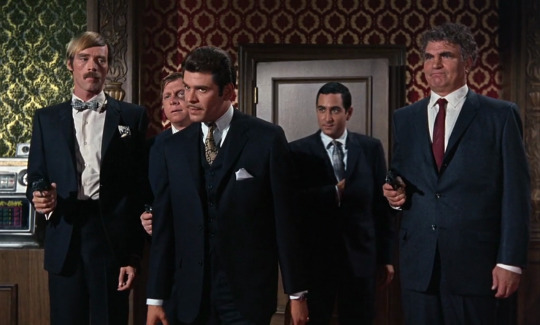
Silky Seymour, oddly enough, is deserving of his own paragraph because he remains one of the most unperturbed villains in the Disney cinematic universe. I sense that Joby Baker is attempting to pull off the reticent coolness of a younger Charles Bronson. Unlike contrasting Disney villains such as Alonzo Hawk, Peter Thorndyke, A.J. Arno, Stratos, and Dan (Neville Brand’s character from That Darn Cat), Silky lacks the frustrated energy, and in this regard, he more closely resembles the George Sanders’ villain, Thomas Ayerton, from In Search of the Castaways (1962). He is a peculiar villain that maintains that posh and polished unconcerned arrogance perfected by George Sanders. Of all the Disney villains, his voice is velvety, almost sexy, and his mannerisms unmistakably bourgeoisie. Similar to the other characters, however, he remains mostly underdeveloped, and there is little to know about him save his gambling enterprises.
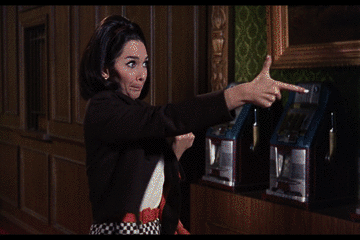
I imagine Stevenson had in mind a subdued Shaggy Dog that would be less occultic and with a less threatening villain. Overall, however, this is a charming film worth viewing for the comedy, and the excellent dynamic played between Ustinov and Jones, and if you are searching for a Halloween film for younger viewers, this is a plus. What has led me to admire this film so ardently is Ustinov’s dialogue, the comedic duo of the two, the delightful friendliness of Blackbeard, and the mischievous peculiarity of Emily Stowecroft. Suzanne Pleshette is a delight as well, always maintaining her strong and dynamic personality, and of all the Disney couples, her and Jones’s portrayal is the most endearing. In the end, it is Ustinov who steals the performance, and it is his unrepeatable skill that breathes life, humor, and atmosphere into the film.

Up the jolly roger!
#blackbeard#disney#vintagedisney#dean jones#peter ustinov#suzanne pleshette#60s#60s film#ghost#pirate#pirates#film review#movies#fantasy#family#romance#halloween#friendship#witches#comedy#comedy movies#old disney#1960s#ghost story
15 notes
·
View notes
Photo
I watched Pollyanna several times growing up. Of course, that was before I kept track of what actors appeared in which films. I discovered the Virginian in college, and yes the 1902 novel as well, and suddenly made the connection that James Drury is George Dodds. I adore Nancy Olson and wish she had appeared in more films. This movie sparkles with feminine magic, fairytale whimsy, and that colorful Edwardian nostalgia that reeks of outdoor bandstands, flowered summer carnivals, and childhood dreams. It’s another one of my all-time favorite mother-daughter films and exploration of friendships. James Drury is quite the romantic in this film too. I miss those innocent, quiet, seemingly uncomplicated romances that made Disney so endearing. It is not meant to be reality but it does give us mere mortals something to dream for, to strive for.
My favorite scenes from the film: assuredly her delight in beguiling the petulance of her grumply neighbors with her glasses of magic and refracted light. I were that every room of my house beheld such cheerish chimes.
˚₊· ͟͟͞͞➳❥ So here’s to a glass of cheer and a reason for being glad. ˏˋ°•*⁀➷








George has been every inch a gentleman with me…
#disney#hailey mills#vintage#vintage disney#james drury#pollyanna#childhood#edwardian#magic#friendship#romance#motherhood#happy
104 notes
·
View notes
Photo

I’ve been doing a dangerous thing: exploring the stupendous world of vintage Disney films. I came across this little gem: The Castaway Cowboy. What I find amazing is that during my childhood I practically managed to watch every ‘old’ disney film I could unearth yet I am boggled at how many I am still finding that I have not yet watched. This film was wildly entertaining featuring a stellar cast including James Garner in a Maverickish role as the shipwrecked Texan cowboy, Costain, and Vera Miles as the determined matron with Robert Culp providing the villainous fracas. A Hawaiian cattle drive was not in my sights and yet here it is.
I am an admitted James Garner aficionado. I only wish he had done more Disney films. Another one I hope to consume soon is One Little Indian, another Disney film starring the Maverick actor, released in 1973. I notice that Vera Miles appears in the cast of this film too. Lovely duo they presented on screen.
For those of you looking for family-friendly material keep an eye on my tumblr. I will be exploring my new finds in frequent journalings.
#disney#james garner#cowboy#hawaii#history#western#vera miles#maverick#70s#70s movies#vintage#vintage disney#family#movies
4 notes
·
View notes
Photo

Aldetha Teach seems like a colorful lady. As purulent as her husband was it is no wonder she practiced the ancient craft. I can’t help but feel that Emily Stowecroft must be some sort of relation to Aldetha perhaps even inhabited by her especially since she has the strange obsession with Blackbeard. Aldetha’s portrait is beautiful as well, albeit a bit eerie. They did a good job of making this look like an 18th century portrait but to me she strongly resembles an adult Mary Beth Mcdonough (look closely and you will see it).

For Historical purposes, however, Aldetha was not Blackbeard’s actual wife. His wife was Mary Ormond. According to Wikipedia, “She was the daughter of William Ormand, a plantation owner from Bath in Somerset. It is believed Blackbeard offered her as a gift to the crew of his ship Queen Anne's Revenge, although her ultimate fate is undocumented.”
3 notes
·
View notes
Quote
What the prisoner listens to there is not his life. It's the shape and shadow of his life... with the accidents of truth taken out of it.
The Chalk Garden (1964)
1 note
·
View note
Photo
This movie is pure gold. The setting, the gloomy English countryside atmosphere, the dialogue, Deborah Kerr’s rivetingly haunted performance. I related so much with Laurel’s bitterness and darkness when I first saw this film as a disgruntled teenager. This sits at the top of my list of favorite films exploring friendship and the past.








The Chalk Garden (1964)
108 notes
·
View notes
Photo

I take it Dick never met Blackbeard? Or maybe he is a bi-polar ghost: intoxicated with depression at one time and thrashing with joy at the next. No wonder Steve had a hard time keeping it all together. I think there at the end he gave in to the insanity anyway.
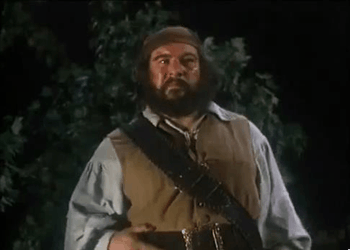
I don’t think Steve could have found a more curiously entertaining friend.
#pirate#fantasy#disney#olddisney#peter ustinov#comedy#gif#history#friendship#quotes#ghost#60s#60s movies#retro#vintage
1 note
·
View note
Photo
Time for some weirdisms. Dean Jones also played as a grown-up Wilby Daniels in the Shaggy Dog sequel the Shaggy D.A. Apparently, he hadn’t learned his lesson not to pick up random spells and read them aloud.
If only this worked for real. I could use a pirate side-kick every now and then.
Can we just appreciate Blackbeard cooly eating a hot dog while the team goes up in flames?





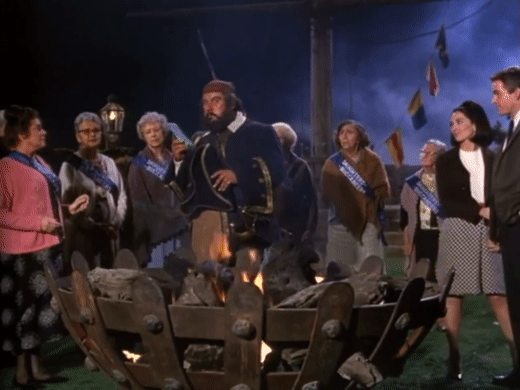
Blackbeard’s Ghost (1968)
#olddisney#disney#peter ustinov#pirates#blackbeard#fantasy#witches#60s#60s movies#vintage#retro#comedy
20 notes
·
View notes
Photo
Why is there not more tumblr fannery for this incredible actor? This is without a doubt the funniest pirate movie I have seen. Peter Ustinov seemed to enjoy whatever role he played no matter how minor or significant.

Blackbeard’s Ghost
1960s storyteller LP
#arrrgghhh#pirate disney peter ustinov blackbear edwardteache withcraft history comedy vintage 1960s retro
15 notes
·
View notes